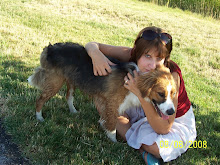Sunday, March 14, 2010
Rules That EVERY Child Should Know
I am very proud of my two children for many reasons, but one reason that always makes me beam is how they act around dogs. I have seen my seven-year-old calmly and directly tell our very smart Border Collie what to do, and, because it never occurred to my daughter that the dog wouldn't, it did! Both of my children know how to be calm, respectful and safe around dogs. In fact, while on a walk recently, my nine-year-old son saw a full grown man being pulled behind an English Bulldog. My son rolled his eyes and said to me "He really needs to learn to be more assertive." I just laughed.
My children have had the benefit of growing up in a home where there has always been a dog, and usually some other kind of foster animal rotating in and out. So it is basically instinct to them how to treat animals, and especially dogs. But if you or your kids are new to dog owning, or even if you don't have a dog, there are some basic rules we should all be teaching our kids for their safety.
Most of us teach kids never to pet a dog unless an adult has said it's safe. That is rule number one. But even "friendly" dogs can bite, scratch, or knock over children who don't know how to approach them.
Here is a list of 3 "MUST TEACH RULES" that all kids should know in order to be safe around dogs.
1. Whenever you meet a dog, be it on a leash, in someone's house, or at the park, NEVER approach it first. In the dog world the one that makes the initital contact is the submissive one. If your child goes up to a dog and begins petting it, even if the owner has said it's okay, the dog will see your child as subordinate. Instead, if a child wants to pet a dog, ask permission, then stand still. Do not talk to, look at, or touch the dog. This says to the dog, "I'm dominant." The dog will likely sniff and smell your child. If it rubs, or licks them first, then it is okay to pet. (Remember to pet under the chin rather than over the head.) If for some reason the dog sniffs and walks away, leave it alone. He is telling you he does not want to interact, and advancing on him may provoke a bite.
2. This rule may save your child's life. If a stray dog is ever charging or launching to attack, make sure you know and your kids know to never run! You can't outrun a dog, and if it is a big dog, you will be in real trouble when it catches you. You may have heard to try to stare down or yell or wave your arms at an attacking dog. DON'T DO THIS! Eye contact is a challenge that you won't win and will only intensify the dog's rage. Yelling will cause the dog to become even more excited, and waving arms will do the same. If you are ever in a situation like this, stand firm and still. Turn sideways and do not look at the dog. Make no sound and put your hands on your hips. A normal dog will not attack unless it feels threatened. By remaining calm and not looking at the dog, you are saying, "I'm no threat, but go away." Tell your children to remain that way, breathing calmly, until the dog leaves or help comes.
3. Make sure your kids know that a hyperactive dog is NOT a dog that you should play with. If a dog, even a small one, is jumping, barking, racing around you in circles, this is not the right time to engage in play. Many kids are hurt when an over-excited dog knocks their legs out, or jumps and scratches them. Many breeds will get nippy when excited and can actually draw blood! Treat an over-excited dog similar to an aggressive dog. Turn away from it and do not talk or touch it. Most dogs will calm down quickly if they are getting no response, but it may take patience on your child's part.
*100% of our children will encounter dogs in their lives. Even if you don't own one and never intend to, there will be dogs at the park, in the neighborhood, at a friend's house and any other number of places. In fact, you children will run into many more dogs than they will "unsafe strangers" so it is just as important to teach them safety around dogs as it is not to talk to strangers or to look both ways when crossing the street. Teach your children these dog rules calmly. Children should not be afraid of a dog, but prepared to handle any dog situation that may occur.
Subscribe to:
Post Comments (Atom)



No comments:
Post a Comment